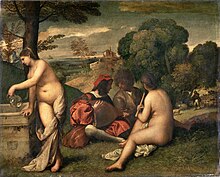Fête champêtre
This article may be expanded with text translated from the corresponding article in French. (May 2020) Click [show] for important translation instructions.
|
This article does not cite any sources. (June 2019) |

A fête champêtre was a form of entertainment in the 18th century, taking the form of a garden party. This form of entertainment was particularly practised by the French court, where at Versailles areas of the park were landscaped with follies, pavilions and temples to accommodate such festivities.
The term is derived from the French expression for a "pastoral festival" or "country feast" and in theory was a simple form of entertainment. In practice, especially in the 18th century, the simplicity of the event was often contrived. A fête champêtre was often a very elegant form of entertainment involving on occasions whole orchestras hidden in trees, with guests sometimes in fancy dress.
A fête champêtre is very similar to a fête galante, although this term is generally more confined to the idealistic fête champêtre as depicted in art.
A painting dated to ca. 1509 currently called Le Concert champêtre or the Pastoral Concert was named Fête champêtre when it entered the collection of the Louvre. It has been attributed to Giorgione, Titian, and Sebastiano del Piombo. The painting is thought to represent a mythological subject, but the correct identification remains elusive for art historians.
See also[]
- European court festivities
- Parties
